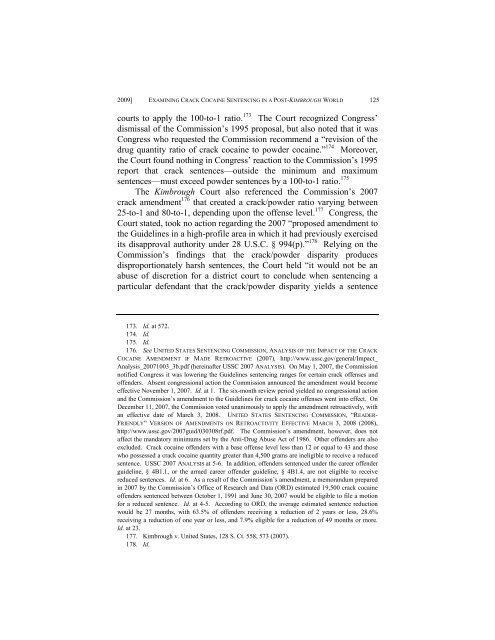Examining Crack Cocaine Sentencing in a Post- Kimbrough World
Examining Crack Cocaine Sentencing in a Post- Kimbrough World
Examining Crack Cocaine Sentencing in a Post- Kimbrough World
You also want an ePaper? Increase the reach of your titles
YUMPU automatically turns print PDFs into web optimized ePapers that Google loves.
08-CASSIDY.DOC<br />
1/29/2009 3:29:23 PM<br />
2009] EXAMINING CRACK COCAINE SENTENCING IN A POST-KIMBROUGH WORLD 125<br />
courts to apply the 100-to-1 ratio. 173 The Court recognized Congress’<br />
dismissal of the Commission’s 1995 proposal, but also noted that it was<br />
Congress who requested the Commission recommend a “revision of the<br />
drug quantity ratio of crack coca<strong>in</strong>e to powder coca<strong>in</strong>e.” 174 Moreover,<br />
the Court found noth<strong>in</strong>g <strong>in</strong> Congress’ reaction to the Commission’s 1995<br />
report that crack sentences—outside the m<strong>in</strong>imum and maximum<br />
sentences—must exceed powder sentences by a 100-to-1 ratio. 175<br />
The <strong>Kimbrough</strong> Court also referenced the Commission’s 2007<br />
crack amendment 176 that created a crack/powder ratio vary<strong>in</strong>g between<br />
25-to-1 and 80-to-1, depend<strong>in</strong>g upon the offense level. 177 Congress, the<br />
Court stated, took no action regard<strong>in</strong>g the 2007 “proposed amendment to<br />
the Guidel<strong>in</strong>es <strong>in</strong> a high-profile area <strong>in</strong> which it had previously exercised<br />
its disapproval authority under 28 U.S.C. § 994(p).” 178 Rely<strong>in</strong>g on the<br />
Commission’s f<strong>in</strong>d<strong>in</strong>gs that the crack/powder disparity produces<br />
disproportionately harsh sentences, the Court held “it would not be an<br />
abuse of discretion for a district court to conclude when sentenc<strong>in</strong>g a<br />
particular defendant that the crack/powder disparity yields a sentence<br />
173. Id. at 572.<br />
174. Id.<br />
175. Id.<br />
176. See UNITED STATES SENTENCING COMMISSION, ANALYSIS OF THE IMPACT OF THE CRACK<br />
COCAINE AMENDMENT IF MADE RETROACTIVE (2007), http://www.ussc.gov/general/Impact_<br />
Analysis_20071003_3b.pdf (here<strong>in</strong>after USSC 2007 ANALYSIS). On May 1, 2007, the Commission<br />
notified Congress it was lower<strong>in</strong>g the Guidel<strong>in</strong>es sentenc<strong>in</strong>g ranges for certa<strong>in</strong> crack offenses and<br />
offenders. Absent congressional action the Commission announced the amendment would become<br />
effective November 1, 2007. Id. at 1. The six-month review period yielded no congressional action<br />
and the Commission’s amendment to the Guidel<strong>in</strong>es for crack coca<strong>in</strong>e offenses went <strong>in</strong>to effect. On<br />
December 11, 2007, the Commission voted unanimously to apply the amendment retroactively, with<br />
an effective date of March 3, 2008. UNITED STATES SENTENCING COMMISSION, “READER-<br />
FRIENDLY” VERSION OF AMENDMENTS ON RETROACTIVITY EFFECTIVE MARCH 3, 2008 (2008),<br />
http://www.ussc.gov/2007guid/030308rf.pdf. The Commission’s amendment, however, does not<br />
affect the mandatory m<strong>in</strong>imums set by the Anti-Drug Abuse Act of 1986. Other offenders are also<br />
excluded. <strong>Crack</strong> coca<strong>in</strong>e offenders with a base offense level less than 12 or equal to 43 and those<br />
who possessed a crack coca<strong>in</strong>e quantity greater than 4,500 grams are <strong>in</strong>eligible to receive a reduced<br />
sentence. USSC 2007 ANALYSIS at 5-6. In addition, offenders sentenced under the career offender<br />
guidel<strong>in</strong>e, § 4B1.1, or the armed career offender guidel<strong>in</strong>e, § 4B1.4, are not eligible to receive<br />
reduced sentences. Id. at 6. As a result of the Commission’s amendment, a memorandum prepared<br />
<strong>in</strong> 2007 by the Commission’s Office of Research and Data (ORD) estimated 19,500 crack coca<strong>in</strong>e<br />
offenders sentenced between October 1, 1991 and June 30, 2007 would be eligible to file a motion<br />
for a reduced sentence. Id. at 4-5. Accord<strong>in</strong>g to ORD, the average estimated sentence reduction<br />
would be 27 months, with 63.5% of offenders receiv<strong>in</strong>g a reduction of 2 years or less, 28.6%<br />
receiv<strong>in</strong>g a reduction of one year or less, and 7.9% eligible for a reduction of 49 months or more.<br />
Id. at 23.<br />
177. <strong>Kimbrough</strong> v. United States, 128 S. Ct. 558, 573 (2007).<br />
178. Id.
















